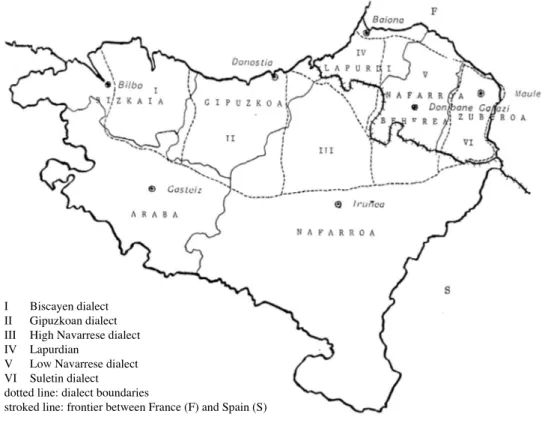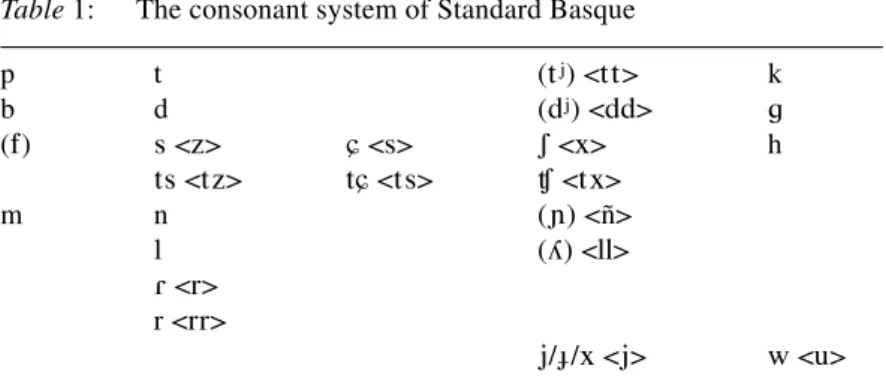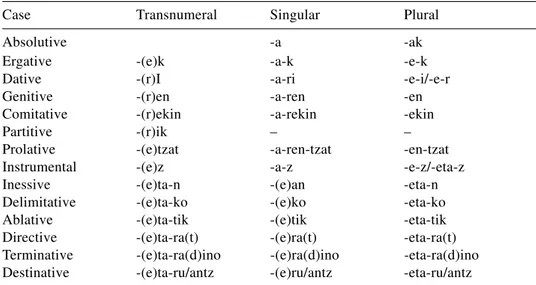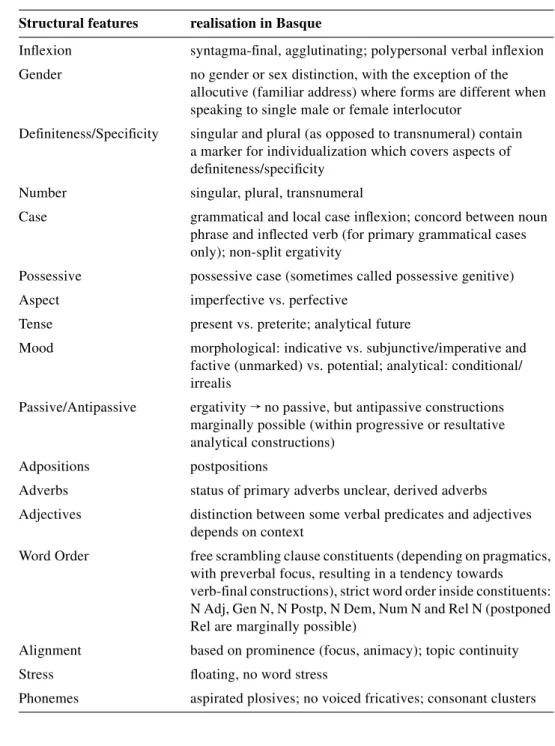Martin Haase
1. General classification 2. Remarks on phonology 3. Word order and focus 4. Syntagmatic inflexion 5. Word classes
6. Conclusion
Basque (Euskara or Euskera) is the only Pre-Indo-European language which has survived the Indo-European invasion of Europe. It is a language isolate, i.e. it is unrelated to other existing languages and is typologically very different from the surrounding language families. It is spoken by about 600,000 speakers (Aizpurua 1995), called euskaldunak in Basque, in an area called Euskal Herria (‘Basque Country’) along the Atlantic Ocean on both sides of the Pyrenees (cf. Map 1).
The frontier between France and Spain divides the Basque Country into a North- Eastern and a South-Western part, commonly called North (Iparralde) and South (Hegoalde). Moreover, the South is subdivided into the autonomous regions (communities) Euskadi and Navarre (Nafarroa), the latter having a mostly Span- ish-speaking population. In spite of a certain autonomy, these regions belong to the kingdom of Spain, although the Basque people do not consider themselves to be Spanish. Almost all speakers of Basque are bilingual: in the South, Castilian Spanish and Navarro-Aragonese (a Romance dialect) are the contact languages; in the North the traditional Romance contact language is Gascon, but nowadays all speakers of this area speak French as well.
The dialects of Basque differ very much from each other, but mutual com-
prehensibility is granted by a standard variety, called Euskara Batua (‘unified
Basque’). Standard Basque (as described in de Rijk 2008) will be the basis of this
typological analysis, which is inspired by Ernst Lewy’s language-immanent ap-
proach to typology (Lewy 1931).
Figure 1: Map of the Basque country (Haase 1992)
1. General classification
Basque is a representative of the agglutinating type with a tendency towards fusion
and a high degree of synthesis, but it is rather difficult to be classified other than
morphologically. As a language isolate it cannot be affiliated to any known lan-
guage family, despite the fact that since the 19th century many scholars have
thought of an affiliation with the Caucasian language group, as Georgian has a
similar case system and a comparatively complex verbal inflexion. In the mean-
time, however, quite a number of unrelated languages have been found which have
an ergative case system (cf. below) and a complex conjugation. In order to prove a
genetic relationship, languages must show systematic grammatical and lexical
similarities. Even hypotheses which are geographically motivated (highlighting
the relationships between Basque and Iberian, as Wilhelm von Humboldt did in the
19th century (Humboldt 1963), or between Basque and Berber) are falsified by the
lack of such similarities (Trask 1995, 1997). Thus, Basque remains a language iso-
late, with Aquitanian as a possible ancestral language (Gorrochategui 1995).
From a typological point of view Basque differs very much from the surround- ing Indo-European languages. Although language contact has brought about gram- matical changes, the language type has not been affected. As can be seen from the examples throughout this article, the morphology of Basque is agglutinating, with a tendency towards fusion. Formal synthesis is high. In the following sections, only the most important characteristics of Basque will be discussed.
2. Remarks on phonology
Basque has the vowel phonemes: a, e, i, o, u, which are pronounced as in Spanish.
Souletin and some dialects of Navarre have a front round vowel /y/, which came up through contact with Gascon. The consonant system of Standard Basque is as fol- lows (graphemes are added in pointed brackets where they differ from the pho- nemic transcription):
Table 1: The consonant system of Standard Basque
The plosives /p/, /t/, /k/ are slightly aspirated in most contexts. The pronunciation of the semi-vowel /j/ differs strongly between dialects (all variants are permitted in the standard). Some dialects partly neutralize the distinction between sibilants.
Moreover, many speakers of Basque (especially in the South-West of the Basque Country) do not pronounce /h/, although it is phonologically relevant in the stan- dard. The bracketed palatal consonants appear phonemically only in forms of fam- iliar address (allocutive, cf. section 4.2), diminutives and hypocorisms; /f/ is li- mited to modern loan words (telefonoa ‘telephone’) and substituted by /p/ in older loan vocabulary (pagoa ‘beech tree’ from Latin fagus). Phonemically, there are no voiced fricatives.
Since the grammar of Basque has as its basic item not the lexical entity, but the phrase (as will be shown in section 3), it is not surprising that Basque lacks word stress. Word groups in focus position are stressed, but there is no fixed ac- cent position (‘floating accent’). Within the phrase, sandhi phenomena can be ob- served:
p t (tj) <tt> k
b d (dj) <dd> !
(f) s <z> " <s> ʃ <x> h ts <tz> t" <ts> ! <tx>
m n ($) <ñ>
l (ʎ) <ll>
ɾ <r>
r <rr>
j/'/x <j> w <u>
3. Word order and focus
The major constituents of a sentence (i.e. phrases) can be moved around freely, i.e.
according to discourse-pragmatic considerations (“scrambling word order”). A highlighted noun phrase or adverbial phrase – often containing new information – is located before the verbal complex. In other words, Basque has a preverbal focus position. The unmarked situation is the following:
Here is a typical example (Lafitte 1979: § 117):
If ‘father’ is emphasized, e.g. when answering the question “Who has thrown the vase?”, the emphasized (inquired) element is preverbal:
In normal conversation untzia (‘vase’) would not be repeated in an answer to a question relating specifically to the vase. The explicit mentioning of untzia is more common if the topic has to be fixed, e.g. when contrasting different topics (‘As far as the vase is concerned, it was thrown by father’). In a less marked way, however, the topic can be mentioned in an afterthought position:
The preverbal focus position must always be filled, even in thetical clauses, i.e. in clauses which do not have a bipartite (given – new, topic – comment) information structure:
(1) Ez da. [esta]
NEG be.3SG.PRS
‘It is not.’
(2) Gusta-tze-n zait. [gusta
tsen
tsajt] as if written: tzait please-VN-INE be.PRS.3SG.1SG.DAT
‘It pleases me./I like it.’
(3) constituents: NP + NP + verbal complex information: given new
topic comment
focus: low high
(4) Aita-k untzi-a aurdiki du.
father-ERG container-IDV throw:PTCP PRS.3SG<3SG
‘Father has thrown the vase.’
(5) Untzia aitak aurdiki du.
‘Father has thrown the vase.’
(6) Aitak aurdiki du untzia.
‘Father has thrown it – the vase.’
The dummy focus element ba- in (7) is called enunciative and etymologically related to bai ‘yes’. It is used in sentences which contain only a synthetically con- structed verb, such as the one in (8):
The focus position of Basque thus appears to be grammaticalized, whereas in many subject-prominent languages, i.e. languages with an obligatory subject position and reflexive constructions (cf. Sasse 1982 and Wehr 1995), focus is achieved by extracting the emphasized constituent (topicalization, dislocation).
Basque can be called a focus-prominent language; it does not have a grammati- calized subject.
Phrase-internal word order is very rigid, as illustrated in (9) to (14) below:
(7) Ba-da bala.
ENC-PRS.3SG ball
‘There was a ball.’
(8) Ba-dakit.
ENC-know.PRS.3SG<1SG
‘I know.’
adjectives (including demonstrative adjectives) follow nouns:
(9) etxe haundi hori house big DEM
2‘that big house’
nouns (in genitive or possessive case) precede nouns:
(10) aita-ren etxe-a father-POSS house-IDV
‘father’s house’
relative clauses precede the relativized noun:
(11) aita-k erosi du-en etxe-a
father-ERG buy.PTCP PRS.3SG<3SG–
SUB
house-IDV
‘the house father has bought’
Basque has postpositions (no prepositions):
(12) iri barne-ko etxe-a town inside-DEL house-IDV
‘the house inside town (i.e. in the town center)’
in affirmative sentences, the finite (auxiliary) verb follows the non-finite verb:
(13) Ikusi dut.
see.PTCP PRS.3SG<1SG
‘I have seen him/her.’
4. Syntagmatic inflexion
The noun phrase always ends in an inflected form, i.e. the basis of inflexion is not the word, but the phrase (phrasal or syntagmatic inflexion):
Syntagmatic relations are not marked by agreement, but are implied by the lack of an ending. The importance of the phrase is also reflected by the accentual system of Basque: not the word, but the phrase is its basic unit, i.e. the accentual emphasis in- creases towards the end of the phrase.
In the verbal complex, the inflected auxiliary (which contains the inflexion for person, number, tense, aspect and mood) follows a non-finite verb form (e.g. the participle, as in (16)). The verbal complex can be modalized by the insertion of an operator before the inflected auxiliary, as in (16b and c); modalization is not achieved by special modal auxiliaries like can, may, must in English:
As shown in (14) above, the order is inverted in negative clauses:
in negative clauses, the order within the verbal complex is inverted:
(14) Ez dut ikusi.
NEG PRS.3SG<1SG see.PTCP
‘I haven’t seen him/her.’
(15) a. etxe-ak ‘houses’
b. etxe haundi-ak ‘big houses’
c. etxe haundi haiek ‘those big houses’
(16) a. Jakin dut.
know.PTCP PRS.3SG<1SG
‘I have known (it/him/her).’
b. Jakin nahi dut.
know.PTCP VOLITIVE PRS.3SG<1SG
‘I want to know (it/him/her).’
c. Jakin behar dut.
know.PTCP OBLIGATIVE PRS.3SG<1SG
‘I must know (it/him/her).’
(17) Ez dut jakin.
NEG PRS.3SG<1SG know.PTCP
‘I haven’t known (it/him/her).’
4.1. Ergative case inflexion
Table 2 shows the case system of Basque. On formal grounds grammatical and local cases can be distinguished. Grammatical cases (in the upper part of the table) mark grammatical relations, local cases (in the lower part of the table) are used for spatial orientation, similar to postpositions, with which they are formally and ety- mologically related.
Table 2: The Basque case system
Basque does not only distinguish between plural and singular, the latter being marked by a special morphological ending – the so-called singulative or individ- ualizer. It has special transnumeral forms (unmarked in grammatical cases, marked in local cases) and is used in the following environments:
a. with indefinite or interrogative pronouns/adjectives:
(18) zenbat etxe? ‘how many houses?’
In this environment, the question does not imply a number, which is why the nu- meral distinction is neutralized and the transnumeral is used here.
b. with numerals:
(19) hiru etxe ‘three houses’
The plural is implied by the numeral already. The plural can be marked if the numeral doesn’t contain any new information, but functions as an appositive con- stituent:
(20) hiru etxe-ak ‘the three houses (I mentioned before)’
Case Transnumeral Singular Plural
Absolutive -a -ak
Ergative -(e)k -a-k -e-k
Dative -(r)I -a-ri -e-i/-e-r
Genitive -(r)en -a-ren -en
Comitative -(r)ekin -a-rekin -ekin
Partitive -(r)ik – –
Prolative -(e)tzat -a-ren-tzat -en-tzat
Instrumental -(e)z -a-z -e-z/-eta-z
Inessive -(e)ta-n -(e)an -eta-n
Delimitative -(e)ta-ko -(e)ko -eta-ko
Ablative -(e)ta-tik -(e)tik -eta-tik
Directive -(e)ta-ra(t) -(e)ra(t) -eta-ra(t)
Terminative -(e)ta-ra(d)ino -(e)ra(d)ino -eta-ra(d)ino
Destinative -(e)ta-ru/antz -(e)ru/antz -eta-ru/antz
c. with partitive case:
(21) Ez da etxe-rik. ‘There is no house.’ or: etxe-rik gabe ‘without house(s)’
Here again, the numeral distinction is neutralized: There is no reference to the ab- sence of a specific number of houses (in the ‘without’ construction this becomes obvious even in the English translation).
d. with instrumental case:
(22) oine-z ‘on foot’
Here only the general concept of the instrument is implied, not a specific number.
There is no distinction of gender in Basque; with the exception of the allocutive, where special forms are used for addressing men or women (cf. (28) in section 4.2 below), gender has not been grammaticalized in Basque.
Basque has an ergative case system. Languages with a nominative-accusative system treat the only participant of an intransitive clause like the agent of a transi- tive clause, leaving both in the typically unmarked nominative (both are con- sidered “subjects” of the clauses), whereas the patient of the transitive sentence (“object”) is marked by accusative case. Ergative systems work the other way round: The agent of a transitive clause gets special ergative case marking, whereas the patient remains unmarked (absolutive case) just like the only participant of an intransitive clause.
Compare the following examples:
In this intransitive sentence, the only participant is txoria ‘the bird’. In a corre- sponding transitive sentence, another participant can be added who does some- thing to ‘the bird’. In Basque this agent appears in ergative case, whereas the pa- tient ‘the bird’ remains unchanged (txoria):
nominative-accusative system
transitive clause agent (NOM) patient (ACC)
intransitive clause only participant (NOM) ergative-absolutive system
transitive clause agent (ERG) patient (ABS)
intransitive clause only participant (ABS)
(23) Txori-a zuhaitz-ean dago.
bird-IDV tree-INE be.3SG.PRS
‘The bird is sitting on the tree.’
(24) Gatu-a-k txori-a arrapa-tze-n du.
cat-IDV-ERG bird-IDV catch-VN-INE PRS.3SG<3SG
‘The cat is catching the bird.’
4.2. Polypersonal verbal inflexion
The personal conjugation of Basque consists of pronominal personal affixes which form the conjugated verb together with a lexically meaningful element:
Only a small class of verbs can be inflected directly, i.e. they can have personal affixes. Here is a list of these so-called synthetical verbs in modern Basque:
izan (intransitive conjugation auxiliary, ‘to be’) ukan (transitive conjugation auxiliary, ‘to have’) egon ‘to stay, to be’
eduki ‘to hold, to have’
jakin ‘to know’
ekarri ‘to bring’
eraman ‘to take (to)’
joan ‘to go (directed)’
ibili ‘to go (undirected), to wander’
etorri ‘to come’
etzan ‘to lie’
eritzi ‘to think’
irudi ‘to seem’ (third person only) (jaugin ‘to come’, in the imperative only)
(very rare: ikusi ‘to see’, erabili ‘to conduct, use’)
In comparison with early records (16th century) the number of synthetically con- strued verbs has significantly decreased.
All other verbs are used in analytical constructions according to the scheme in (26) and exemplified in (27):
In (27) note that the verb form in the interlinear morphemic translation has been morphologically analysed. Due to its high degree of synthesis and a tendency towards fusion, this can only be a tentative analysis, though. That is the reason why such a close analysis is not given in other examples. A hyphen before and after a morpheme indicates that it can only be found within a verb form:
(25) Ba- d- -a- -ki- -t.
ENC- ABS.3.PRS- -PRS- -know- -ERG.1SG
INDICATIVE root
‘I know (it/him/her).’
(26) infinitival form (optional operator) conjugation auxiliary
(27) ema(i)-te-n d- -io- -t.
give-VN-INE ABS.3.PRS- -DAT.3SG- -ERG.1SG [infinitival form] INDICATIVE
‘I am giving it to him/her.’
In (27) the conjugation auxiliary contains personal affixes for three partici- pants. However, it is even possible to find a fourth personal affix in such construc- tions for reference to the hearer:
In these familiar allocutive forms, the sex of the person spoken to is marked. Such familiar forms vary quite a lot between dialects (and even within them). They are not standardized. The verb form in (28) is typical of Navarre (Bonaparte 1991: I, 437).
Even if reflexives are excluded, the combination of up to four person markers in two tenses and four moods leaves us with a huge amount of combinations (about 3000 verb forms). More temporal categories (as well as modal and aspectual ones) are formed by adding case markers to the infinitival form. A detailed account is given in Haase (1994).
5. Word classes
Lexical entities can be attributed to word classes only according to the syntactic (syntagmatic) context in which they appear.
In (29) ezti which means ‘honey’ or ‘sweet’, seems to be an adjective or an intran- sitive verb (‘to honey, to sweet’). In (30) it is a noun (‘honey’):
The distinction between verbs and adjectives is purely morphological:
In (31) eri functions as a verb (‘to be ill’), whereas in (32) eri comes with the in- dividualizer -a which makes it more noun-like and denotes a permanent character- istic.
(28) Ema(i)-te-n z- -io- -na- -t.
give-VN-INE ABS.3.FAM- -DAT.3SG- -FAM.F- -ERG.1SG(PRS)
‘I give it to him/her, woman.’
(29) Ezti da.
honey be.3SG.PRS
‘It is sweet.’ lit. ‘It honeys.’
(30) Ezti-a gusta-tzen zait.
honey-IDV please.PRS3SG.1SG.DAT
‘I like honey.’
(31) Eri da.
ill be.3SG.PRS
‘(S)he is ill.’
(32) Eri-a da.
ill-IDV be.3SG.PRS
‘(S)he is invalid/sickish.’
The previously mentioned verbal or modal operators are particularly difficult to categorize. Take, for example, the operators nahi and ohi. They can function as verbs, like nahi in (33):
But with the individualizer, nahia means ‘wish’ or ‘wanted’, as in nere nahia ‘my wish’ or erantzun nahia ‘the wanted answer’. Likewise, ohi expresses habitual as- pect as in (34):
As an attributive adjective, ohi means ‘dead’ (e.g. in apez ohia ‘the dead priest’).
This clearly shows how much word classes are determined by the syntagmatic con- text in Basque, which comes as no surprise in a language whose fundamental gram- matical unit is the phrase.
6. Conclusion
The key entity of Basque grammar is the phrase. Noun phrases can be moved around within the clause, depending on discourse-pragmatic considerations. The main focus is placed immediately before the verb. Informationally less important constituents can be added as afterthoughts following the verb, which is otherwise clause-final (for example in subordinate clauses). The syntax of Basque can there- fore be characterized as focus-prominent and phrase-based (syntagmatic). Within the phrase the constituent order is fixed. Case endings are positioned at the end of the noun phrase. Most verbs are inflected by special tense auxiliaries which contain person markers for up to four case roles (absolutive, ergative, dative and allocu- tive, polypersonal inflection).
The major typological features of Basque are summarized in Table 3.
(33) nahi-ko du.
want-FUT have.3SG<3SG.PRS
‘(S)he will want it.’
(34) Euskara-z mintza-tze-n ohi zen.
Basque-INS speak-VN-INE HAB be.3SG.PRT
‘(S)he used to speak (in) Basque.’
Table 3: Typological features of Basque
Structural features realisation in Basque
Inflexion syntagma-final, agglutinating; polypersonal verbal inflexion Gender no gender or sex distinction, with the exception of the
allocutive (familiar address) where forms are different when speaking to single male or female interlocutor
Definiteness/Specificity singular and plural (as opposed to transnumeral) contain a marker for individualization which covers aspects of definiteness/specificity
Number singular, plural, transnumeral
Case grammatical and local case inflexion; concord between noun phrase and inflected verb (for primary grammatical cases only); non-split ergativity
Possessive possessive case (sometimes called possessive genitive)
Aspect imperfective vs. perfective
Tense present vs. preterite; analytical future
Mood morphological: indicative vs. subjunctive/imperative and factive (unmarked) vs. potential; analytical: conditional/
irrealis
Passive/Antipassive ergativityf no passive, but antipassive constructions marginally possible (within progressive or resultative analytical constructions)
Adpositions postpositions
Adverbs status of primary adverbs unclear, derived adverbs Adjectives distinction between some verbal predicates and adjectives
depends on context
Word Order free scrambling clause constituents (depending on pragmatics, with preverbal focus, resulting in a tendency towards verb-final constructions), strict word order inside constituents:
N Adj, Gen N, N Postp, N Dem, Num N and Rel N (postponed Rel are marginally possible)
Alignment based on prominence (focus, animacy); topic continuity
Stress floating, no word stress
Phonemes aspirated plosives; no voiced fricatives; consonant clusters
Bibliography Aizpurua, Xabier
1995 Euskararen jarraipena. La continuidad del euskera. La continuité de la langue basque. Vitoria-Gasteiz: Eusko Jaularitza.
Bonaparte, Louis-Lucien
1991 Opera omnia vasconice. 4 vols. Bilb(a)o: Euskaltzaindia.
de Rijk, Rudolf P.G.
2008 Standard Basque. A Progressive Grammar. Cambridge, Mass.: MIT Press.
Gorrochategui, Joaquín
1995 The Basque language and its neighbors in antiquity. In: José Ignacio Hualde, Joseba A. Lakarra and Robert Lawrence Trask (eds.),Towards a History of the Basque Language, 31–63. Amsterdam/Philadelphia: Benjamins.
Haase, Martin
1992 Sprachkontakt und Sprachwandel im Baskenland: Die Einflüsse des Gaskogni- schen und Französischen auf das Baskische. Hamburg: Buske.
Haase, Martin
1994 Tense and aspect in Basque. In: Rolf Thieroff and Joachim Ballweg (eds.), Tense Systems in European Languages [I], 279–292. Tübingen: Niemeyer.
Humboldt, Wilhelm von
1963 Bemerkungen auf einer Reise durch Biscaya und das französische Basquen- land im Frühling des Jahres 1801, nebst Untersuchungen über die Vaskische Sprache und Nation, und einer kurzen Darstellung ihrer Grammatik und ihres Wörtervorraths. In: Andreas Flitner and Klaus Giel (eds.),Wilhelm von Humboldt: Werke in fünf Bänden. Vol. 3: Schriften zur Sprachphilosophie, 418–627. Darmstadt: Wissenschaftliche Buchgesellschaft.
Lafitte, Pierre
1979 Grammaire basque (navarro-labourdien littéraire). Donostia/San Sebastián:
Elkar.
Lewy, Ernst
1931 Skizze einer elementaren Syntax des Baskischen. Caucasica 9: 88–128;
wieder in: Lewy, Ernst 1961Kleine Schriften, 521–562. Berlin: Akademie.
Sasse, Hans-Jürgen
1982 Subjektprominenz. In: Sieglinde Heinz and Ulrich Wandruszka, (eds.),Fakten und Theorien. Festschrift für Helmut Stimm, 267–286. Tübingen: Narr.
Trask, Robert Lawrence
1995 Origins and relatives of the Basque language: Review of the evidence. In: José Ignacio Hualde, Joseba A. Lakarra and Robert Lawrence Trask (eds.),Towards a History of the Basque Language, 65–99. Amsterdam/Philadelphia: Benja- mins:
Trask, Robert Lawrence
1997 A History of the Basque Language. London: Routledge.
Wehr, Barbara
1995 SE-Diathesen im Italienischen. Tübingen: Narr.



